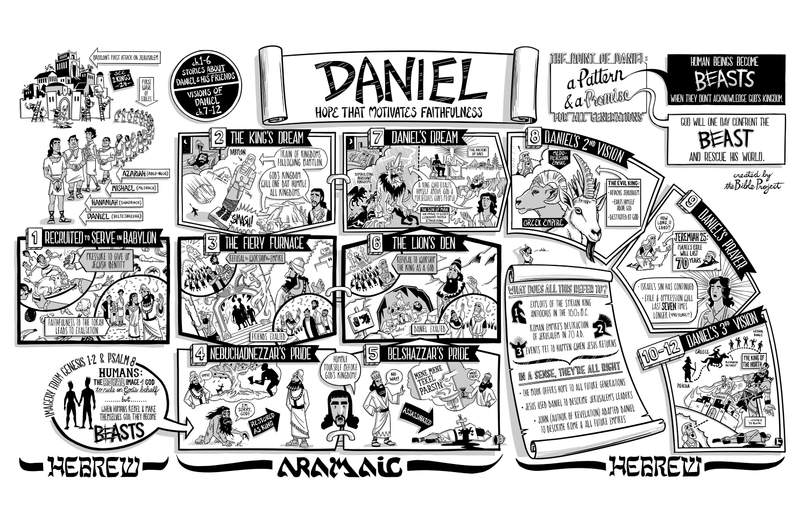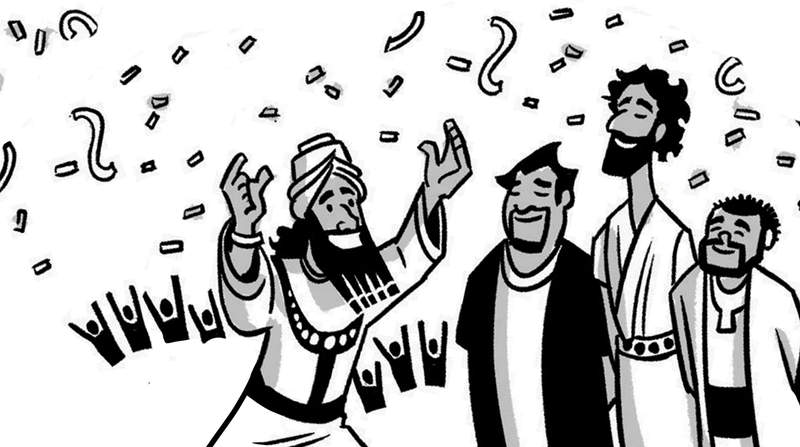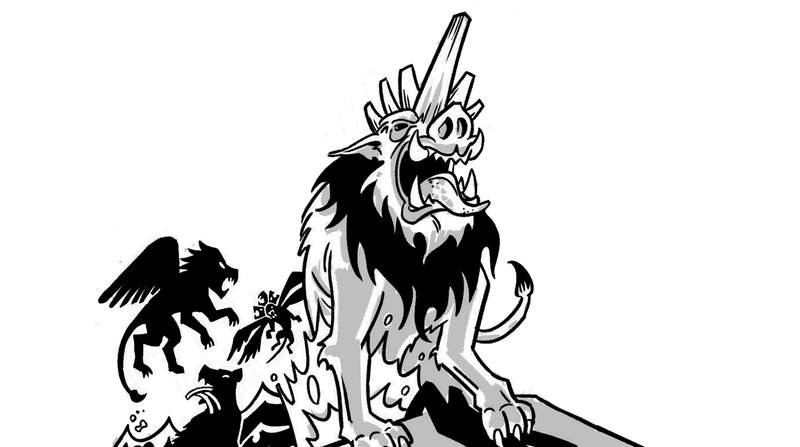The Book of Daniel
About

Daniel’s story is set right after Babylon’s first attack on Jerusalem (2 Kgs. 24). They had plundered the city and the temple, taking a wave of Israelites into exile. Among these prisoners were four men from the royal family line of David: Daniel, later named Belteshazzar, and his three friends, who you probably know by their Babylonian names of Shadrach, Meshach, and Abed-nego. This book tells of their struggles to maintain hope in the land of their conquerors.
Who Wrote the Book of Daniel?
Context
Key Themes
- Faithful living in the midst of a culture opposed to God
- God’s comfort in the midst of oppression
- Hope for God’s future restoration
Structure
The Literary Design of the Book of Daniel
The book’s design seems simple at first. Chapters 1-6 contain stories about Daniel and his friends in Babylon, while chapters 7-12 contain Daniel’s visions about the future. This two-part shape is made more interesting by another design feature, namely, the fact that it’s written in two languages. The book begins with chapter 1 written in Hebrew, the language of the Israelites, but chapters 2-7 are written in Aramaic, a cousin language to Hebrew that was spoken widely among the ancient empires. Meanwhile, chapters 8-12 go back to Hebrew. This design shows not only how the Aramaic chapters 2-7 are a coherent section but also highlights how chapters 2 and 7 are important for understanding the later chapters of the book.
Daniel 1-6: Dreams, Visions, and Persecutions
Chapter 1 introduces the basic plot tension that drives the entire story. Daniel and his friends are wise and capable and are soon recruited to serve in the royal palace of Babylon. However, they are also pressured to give up their Jewish identity by living and eating like Babylonians and violating the Jewish food laws found in the Torah. They refuse and instead choose faithfulness to the Torah. This decision puts them in grave danger, but God delivers them, and they go on to be elevated by the king of Babylon.
After this comes the Aramaic section, which has its own special, symmetrical design. The king of Babylon has a dream that only Daniel is able to interpret. It’s about a huge statue that dominates the landscape and is made up of four types of metal. Daniel says the statue symbolizes a sequence of kingdoms, with Babylon as the head. Suddenly, a huge rock flies in and shatters the statue, turning it into a mountain. Now, this dream is the first of many symbolic visions in the book, but this one introduces a basic storyline. Daniel says that the statue represents a train of human kingdoms following after Babylon that will fill God’s world with violence. One day, however, God’s Kingdom will come and humble the arrogant nations of the world, filling the earth with the healing and justice of God.
After this, chapter 3 tells the famous story of Daniel’s three friends. They refuse to bow down and worship a huge idol statue, which represents the king and his imperial power, just like the statue in the previous chapter. The friends are persecuted for their choice and thrown into a fiery furnace. Once again, God delivers them from death, and they’re exalted by the king who now acknowledges their God as the true one.

Chapters 4 and 5 make up a pair of stories about two Babylonian kings—Nebuchadnezzar and his son Belshazzar. Both are filled with pride because of their power, so, as in chapter 2, God warns them both through dreams and visions. Again, just like in chapter 2, only Daniel can interpret for them. After doing so, he tells both kings that they are to humble themselves before God, and they both arrogantly resist. Nebuchadnezzar is stricken with madness and becomes like a beast in the fields. Eventually, he does humble himself before God, and as his humanity returns, he is restored as king. This contrasts with his son Belshazzar, who does not humble himself and is assassinated that very night.
These two stories draw their imagery from Genesis 1-2 and Psalm 8, in which humans are depicted as the royal image of God and appointed to rule over the beasts on behalf of God, who is the world’s true King. When human kingdoms forget that they are not God, when they exalt their own power as divine, they become less than human and more like violent beasts who will face God’s justice.
This brings us to chapter 6, the pair of chapter 3. This time, it’s Daniel who’s persecuted because he refuses to pray to and worship the king as a god. So, like the friends, he is sentenced to death and thrown into a lion’s den. God delivers him from the beasts, and, like the friends, the king exalts Daniel and praises his God.
Chapter 7: Daniel’s Dream of the Four Beasts and the Son of Man
We finally come to chapter 7, the pair of chapter 2 and the center of the book of Daniel, where all the themes come together. The focus of the story is another dream, but this time it’s Daniel’s. Ironically, he can’t understand it until an angelic messenger explains it to him. Daniel sees a series of four beasts. Three of them are like a lion, a bear, and a winged leopard, and each symbolizes arrogant kingdoms. The last creature is a monstrosity, identified as a terribly evil empire. This fourth beast has lots of horns—a common symbol for kings in the Old Testament—with one specific horn that represents a king who arrogantly exalts himself above God and persecutes his covenant people. The symbol for God’s people is a figure called the “Son of Man,” who is both an image of God’s covenant people and their king from the line of David. God, who’s referred to as “the Ancient of Days,” comes to set up his throne. He destroys the great monster and exalts the Son of Man to the clouds, where he sits at God’s side and shares in God’s rule over the nations.

We can now look back and see how all these stories and dreams work together. The three stories of faithfulness despite persecution (chs. 1, 3, and 6) are meant to offer hope to God’s suffering people among the nations. They suffer because human kingdoms have rebelled against God and have become beasts (chs. 4 and 5). The visions (chs. 2 and 7) encourage patience that waits for God to bring his rule over the world and vindicate his people. But when is God going to do this? That question is what the final three visions in chapters 8, 9, and 10-12 set out to explore.
Daniel 8-12: Visions of Future Kingdoms and an Angelic Visit
In chapter 8, Daniel has another vision about the final two beasts from the previous chapter. This time, they are symbolized by a ram (which we’re told is an image of the empire of the Medes and Persians) and a goat (an image of ancient Greece). Out of the goat comes a bunch of horns, one of which symbolizes the evil king of chapter 7. In this vision, we’re given a little more information about this king. He will attack Jerusalem and exalt himself above God by defiling the temple with idols. However, in the end, this king will be destroyed by God, who will in turn exalt his people and kingdom.
Now, in chapter 9, Daniel is puzzled as to when all this will take place. He consults the scroll of the prophet Jeremiah, where God said that Israel’s exile would last for 70 years before God would restore them. For Daniel, the 70 years are almost up, and he asks God to fulfill his promise. However, an angel comes and informs Daniel that Israel’s sin and rebellion hasn’t been fully dealt with by the exile, and their times of oppression under the nations will last seven times longer than Jeremiah had envisioned.
Daniel is deeply disturbed, and he has one final vision that spans chapters 10-12. We’re shown the same sequence of kingdoms—Persia, then Greece and Alexander the Great, followed by lesser kings that all lead up to the final “king of the north.” He will invade Jerusalem, set up idols in the temple, and exalt himself above God. The vision concludes, like the others, with this king suddenly coming to ruin.
Now, there have been endless debates about what all these visions refer to. Many see a clear connection to the exploits of the Syrian king Antiochus during the mid-second century B.C.E. He killed many faithful Jews in Jerusalem and set up idols in the temple. Others think that they point forward to the Roman empire’s role in the execution of Jesus and the destruction of Jerusalem and its temple in 70 C.E. Still others think that it all will be fulfilled in the future events that will happen when Jesus returns.
The problem is that the symbols and numbers don’t quite match any of these views perfectly, which opens up the possibility that, in a sense, they are all right. The book of Daniel has been designed to offer hope to all future generations of God’s people. It did so in the days of Antiochus’ empire, and it has ever since. That’s why Jesus used imagery from Daniel to accuse the oppressive leaders he confronted in Jerusalem (Mark 14:62), and it’s why John, who wrote The Revelation, adapted Daniel’s visions and applied them to the Roman empire of his day as well as all future oppressive empires (Rev. 13).
The book of Daniel offers readers of all generations an insight into God’s promise and a pattern at work in history. The pattern reveals how humans and their kingdoms become violent beasts when they glorify their power and don’t acknowledge God as their true King. But Daniel’s visions also hold out a promise that one day God will confront the beast, rescue his world and his people, and bring his Kingdom. This book is for every generation, and it speaks a message of hope that motivates faithfulness.